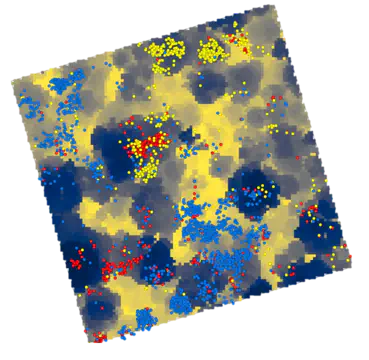Msc project: A spatial analysis of three tree species at seedling stage on parcel 16 of Paracou experimental site.

Authors: Stephan Cassin, Sophie Hoppe
Supervisors: Sylvain Schmitt, Guillaume Salzet, Melaine Aubry-Kientz
Abstract: Forest regeneration is governed by regeneration of tree species and individuals, regulated by biotic and abiotic factors. In this study we were interested in the spatial distribution of three tree species at the seedling stage at the Paracou experimental site: Dicorynia guianensis, Symphonia globulifera and Tachigali melinonii. Our results highlight a strong aggregated pattern distribution for all three species. Seedling density is highly structured by distance to the Nearest Adult Neighbour (NAN) concurrent with species’ dispersion strategy and Janzen-Connell hypothesis. We used Digital Canopy Model (DCM) to estimate light availability, distance to the nearest water the courses and Topographic Wetness Index (TW!I) to characterise soil moisture. D. guianensis’ seedlings were mosily found in light areas (mean DCM of 28.88 meters) and S. globulifera on hydromorphic soil (mean Chanel Distance of 0.39 meters, mean TWI of 38.84). Contrary to bibliographic sources, T. melinonii’s seedlings were found in shade areas (DCM of 33.64 meters). This could be due to competition with D. guianensis excluding T. melinoniïs seedling from light areas, and plasticity toward light allowing its seedlings to grow in drained shade areas.